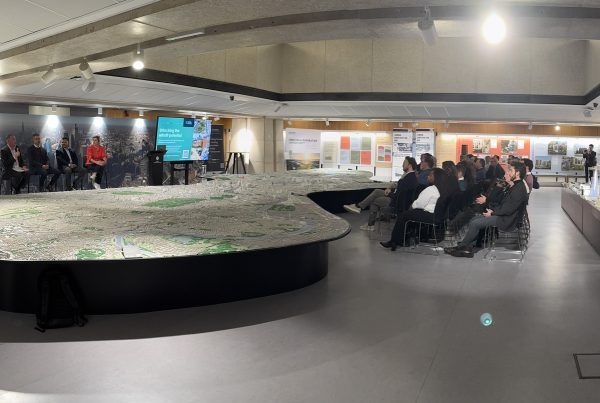
With industries constantly adapting to align with new regulations and the changing landscape of the world, sustainability is becoming an increasing priority for companies, particularly in response to regulations and environmental concerns. In the construction industry, sustainability is a key focus due to the consumption and waste levels that development is linked to. However, modern construction has many ways of supporting sustainability goals through the use of recycled materials, utilising energy efficiency and sustainable design. Sustainability is extremely important, not only as it has a huge positive impact on the environment but also benefits the businesses that develop and the consumers who ultimately use the buildings.
Leaders within the sustainable construction industry utilise eco-friendly materials and practices to build energy-efficient developments. While Thames Freeport is not directly responsible for large-scale housing projects, it plays a key role in promoting sustainability and innovation within its operational areas. Through initiatives like the Smart Homes Innovation Hub in Barking, in collaboration with the Seoul Digital Foundation and Connected Places Catapult, Thames Freeport supports advancements in energy-efficient housing solutions. Additionally, its commitment to decarbonisation and clean energy technologies contributes to broader environmental goals, fostering sustainable practices in logistics, manufacturing, and infrastructure development.
The Advantages of Sustainable Construction to the Environment
When it comes to sustainable construction, it is the environment that benefits the most. With global efforts to combat climate change, construction is one industry that can help tackle these goals on a large scale by implementing sustainability measures and reducing the carbon footprint. Sustainable construction has a wide-scale impact, benefiting local communities, contributing to national sustainability goals, and aligning with international efforts to reduce carbon emissions.
Lower Carbon Emissions
A key priority of sustainable construction is reducing carbon emissions, alongside improving resource efficiency, reducing waste, and protecting biodiversity. By utilising energy-efficient designs and using renewable energy sources, construction sites can lower their carbon footprint and help with international goals of working towards net zero. Carbon emissions are not only considered during the build process, infrastructure is also implemented into the buildings to ensure reduced carbon emissions long term.
Conservation of Natural Resources
By incorporating recycled and renewable materials, sustainable construction helps reduce reliance on finite resources like timber, metal, and fossil fuels. It also reduces the need for newly produced materials by making use of what is already in existence. This conservation of natural resources not only protects these resources for future generations, it also helps to reduce carbon emissions in addition to preserving ecosystems and biodiversity.
Protection of Biodiversity
Protecting biodiversity helps maintain ecosystems and can indirectly support climate resilience by preserving carbon sinks such as forests and wetlands. Firstly, this means accurately selecting the location for construction to ensure that nature and biodiversity are impacted the least. The construction process involves the use of non-toxic materials and lower emissions to ensure that pollution and toxins are not released into the local environment. It also includes implementing environmentally friendly infrastructure into buildings to ensure that biodiversity is protected long-term through continued energy efficiency and low emissions.
Waste Reduction
Sustainable construction incorporates strategies to minimise waste generation and improve waste management through recycling and efficient resource use. By predominantly using recycled materials, this limits the amount of material going to landfills, reducing physical and airborne pollutants. It also reduces emissions making this waste easier to control and manage pollution. By using non-toxic, low-emission materials and sustainable site management practices alongside effective management of any emissions, it creates a healthier environment for the local community, protects biodiversity in the area and helps global efforts to combat climate change.
Water and Energy Conservation
Both water and energy are heavily consumed resources in construction, making conservation efforts crucial for sustainability. Sustainable construction can implement methods and strategies into construction sites to conserve energy and reduce water wastage. In the UK, construction sites are slowly implementing the use of renewable energy, not only in the construction phase but also built into the infrastructure of the building for long-term benefits.
The Port of Tilbury, part of Thames Freeport, plays a key role in the UK’s recycling sector, supporting the circular economy by processing and handling large volumes of recycled materials.
The Advantages of Sustainable Construction to Construction Companies
Construction companies can implement sustainable practices into their businesses and development projects to help achieve global, national and personal goals. Sustainable construction helps companies stay aligned with new regulations that promote eco-friendly methods of construction but also benefit the company in many ways.
Cost Savings
While the initial implementation of sustainable practices is an investment, long-term, construction companies will reap the financial rewards. By using energy-efficient materials and techniques, companies will save costs on construction projects over time. Sustainable practices that minimise construction waste can help lower disposal costs and improve project efficiency, though initial investments in eco-friendly materials may require financial planning. In addition, tax relief and incentives are often offered to businesses for implementing ‘green’ practices which will ultimately make projects more cost-effective.
Competitive Edge
Sustainable construction is becoming the industry standard, and companies that adopt eco-friendly practices early gain a competitive edge in regulatory compliance and market appeal. Utilising sustainable construction methods meets the market demand for eco-friendly practices on both a consumer level and in alignment with regulation. Companies that adopt sustainable construction are more appealing to clients who are environmentally conscious with sustainability efforts boosting brand image and attracting clients who value eco-friendly, innovative construction methods. It also helps to create long-term partnerships with clients who appreciate the values of the company with potential repeat business.
Regulatory Compliance
By adopting sustainable construction practices, companies can align with current regulations and better prepare for stricter environmental policies in the future. Sustainable construction can not only align with current environmental regulations but it can also help prepare for stricter future policies. This can help companies avoid fines and project delays when new regulations come into practice with no need to spend time and money to catch up to compliance level.
The Advantage of Sustainable Construction to Consumers
Construction is designed for consumers whether developments are residential or commercial. It is therefore ultimately the consumers who will benefit from sustainable construction. Construction companies can implement infrastructure into the building process that will benefit the consumers long term.
Financial Savings
Sustainable construction focuses on energy efficiency and emission reduction that can help consumers save money long term. Whether the building is residential, saving money for tenants and homeowners, or commercial, reducing costs for businesses, these measures can help consumers save on utility bills. Sustainable construction also prioritises durability, resulting in lower maintenance costs and less need to renovate.
Public Health
Public health is a major benefit of sustainable construction. When construction sites are built in a way that protects local biodiversity, it supports the well-being of the local community by promoting nature and limiting toxins, all of which create a healthier environment through improved air quality and reduced pollution. Sustainable construction enhances indoor air quality by incorporating non-toxic materials, improved ventilation, and air filtration systems, benefiting occupant health.
Increased Property Value
For homeowners and business owners who purchase a building, they will benefit from increased property value on sustainable construction. Eco-friendly features are highly sought after, making properties more attractive to potential buyers and increasing resale value. Sustainable construction is also a way of future-proofing your home or commercial property by staying ahead of the game in terms of future compliance and safeguarding the value of the building.



